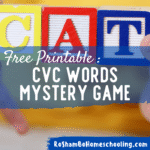(This post contains affiliate links.)

Oh, the dreaded lowercase ‘b’ and ‘d.’ The torment of every parent who has homeschooled a preschooler. Of all the steps that go into teaching our kiddos to read, b/d differentiation is the one I see the most questions about in homeschool groups.
When my son was learning lowercase letters, b/d differentiation is the skill he was stuck on for the longest. I had cutesy ways of explaining all the other letters to him in a way that made sense and stuck. We had long discussions about the differentiating features of the alphabet.
“Only two letters have polka dots. Can you find them?” “The ‘m’ has two bumps, the ‘n’ has one bump, and the ‘r’ has a half a bump. It’s like the ‘r’ was trying to make a whole bump, but then someone said ‘STOP!’ halfway through.” “The ‘g’ has a forward hook, and the ‘q’ has a backwards hook.” And so on and so on until he knew them all.
But the ‘b’ and ‘d’ felt like they took forever to teach. I tried a bunch of different methods to help him understand.
The ‘Bed’ Method
One of the most popular approaches to b/d differentiation is called the ‘bed’ method. It looks like this:

Basically, you show your child a photo like this one and explain that the b is always the headboard and the d is always the footboard. The more they look at a picture like this, the more the image and the letters stick in their brain. The next time they’re trying to decide if the letter they see is a ‘b’ or a ‘d,’ they can close their eyes and recall this image to help them figure it out.
This works great for visual learners. (Not sure if your child is a visual learner or not? Here’s an awesome quiz for figuring out what type of learner your child is!)
This method helped my son slightly, but he was still shaky. I decided I wanted to try something more active and kinesthetic.
Musical b/d Differentiation

I made these small stickers with ‘b’ and ‘d’ on them and attached them to our keyboard. All I told him was ‘b’ is for black, showing him the ‘b’s on the black keys. And off he went, merrily playing (banging on) the keyboard for the next hour.
And it finally stuck!
No preschooler wants to just stare at a flashcard for an hour. But playing the piano and casually staring at ‘b’ and ‘d’ for an hour? That’s actually fun!

This free printable includes ‘b’ and ‘d’ squares for each key. There are enough to cover a keyboard or a full-sized piano. I printed mine on colored cardstock so it would pop more. You can also use sticker paper if you want the fastest possible set up.
Looking for even more play-based ABC activities? Check out my ABC Cheerio Tracing Sheets, Beginning Sounds Bingo, and Beginning Sounds with Board Games.



